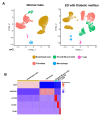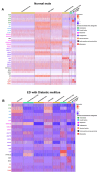Exploring the Molecular Link Between Diabetes and Erectile Dysfunction Through Single-Cell Transcriptome Analysis
- PMID: 39766863
- PMCID: PMC11675191
- DOI: 10.3390/genes15121596
Exploring the Molecular Link Between Diabetes and Erectile Dysfunction Through Single-Cell Transcriptome Analysis
Abstract
Erectile dysfunction (ED) is a pathophysiological condition in which the patients cannot achieve an erection during sexual activity, and it is often overlooked yet prevalent among diabetic men, globally affecting approximately 35-75% of diabetic individuals. The precise mechanisms through which diabetes contributes to ED remain elusive, but the existing literature suggests the potential involvement of nerve and vascular damage that affects the penile supply. In the present review, we reanalyze the existing human single-cell transcriptomic data from patients having diabetes mellitus-associated ED with normal erections. The analysis validates the expression of genes associated with antioxidative pathways, growth factors, adipokines, angiogenesis, vascular functions, penile erection, sexual function, and inflammation in diverse cell types from healthy individuals and those with ED. Our transcriptomic analysis reveals alterations in the expression of adiponectin receptors in the pathogenesis of ED compared to their counterparts in healthy subjects. This comprehensive review sheds light on the molecular underpinnings of ED in the context of diabetes, providing an in-depth understanding of the biological and cellular alterations involved and paving the way for possible targeted therapeutic discoveries in the field of diabetes-associated male infertility.
Keywords: diabetes; diabetic sexual health; erectile dysfunction; human single-cell transcriptome data; men’s sexual health; microvascular complications; single-cell analysis.
Conflict of interest statement
The authors declare no conflict of interest.
Figures





Similar articles
-
Single-cell transcriptome analysis of cavernous tissues reveals the key roles of pericytes in diabetic erectile dysfunction.Elife. 2024 Jun 10;12:RP88942. doi: 10.7554/eLife.88942. Elife. 2024. PMID: 38856719 Free PMC article.
-
Gene expression profile comparison in the penile tissue of diabetes and cavernous nerve injury-induced erectile dysfunction rat model.Investig Clin Urol. 2016 Jul;57(4):286-97. doi: 10.4111/icu.2016.57.4.286. Epub 2016 Jul 12. Investig Clin Urol. 2016. PMID: 27437539 Free PMC article.
-
Differentially expressed angiogenic genes in diabetic erectile tissue - results from a microarray screening.Mol Genet Metab. 2012 Feb;105(2):255-62. doi: 10.1016/j.ymgme.2011.11.002. Epub 2011 Nov 10. Mol Genet Metab. 2012. PMID: 22133301
-
New treatment options for erectile dysfunction in patients with diabetes mellitus.Drugs. 2004;64(23):2667-88. doi: 10.2165/00003495-200464230-00004. Drugs. 2004. PMID: 15537369 Review.
-
Current Status and Prospects in the Treatment of Erectile Dysfunction by Adipose-Derived Stem Cells in the Diabetic Animal Model.Sex Med Rev. 2020 Jul;8(3):486-491. doi: 10.1016/j.sxmr.2019.09.006. Epub 2020 Jan 21. Sex Med Rev. 2020. PMID: 31980404 Review.
References
-
- CDC Global Health—Infographics—World Diabetes Day. [(accessed on 3 October 2023)];2020 Available online: https://www.cdc.gov/globalhealth/infographics/diabetes/world-diabetes-da....
-
- Diabetes PAHO/WHO: Pan American Health Organization. [(accessed on 8 December 2023)]. Available online: https://www.paho.org/en/topics/diabetes.
-
- Mohiuddin M.S., Himeno T., Inoue R., Miura-Yura E., Yamada Y., Nakai-Shimoda H., Asano S., Kato M., Motegi M., Kondo M., et al. Glucagon-Like Peptide-1 Receptor Agonist Protects Dorsal Root Ganglion Neurons against Oxidative Insult. J. Diabetes Res. 2019;2019:9426014. doi: 10.1155/2019/9426014. - DOI - PMC - PubMed
Publication types
MeSH terms
LinkOut - more resources
Full Text Sources
Medical

